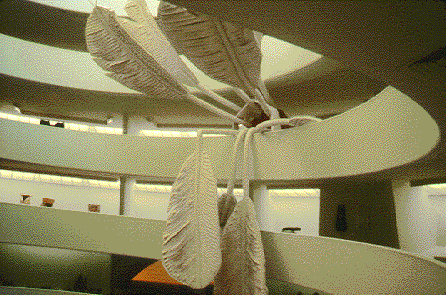
Giant Soft Shuttlecock, 1994.
"need the rest of this i.d."]

Giant Soft Shuttlecock, 1994.
"need the rest of this i.d."]
For nearly twenty years, Oldenburg has collaborated with writer Coosje vanBruggen to produce a series of large-scale outdoor projects, which have beenrealized in many urban settings in the United States and Europe. These publicsculptures relate to their sites both formally and conceptually. They arerepresented in this exhibition by small-scale models and drawings, as well asby a full-scale replica of the Des Moines Crusoe Umbrella and a giant soft shuttlecock based on the design of the four shuttlecocks installed outside the Nelson-Atkins Museum of Art in Kansas City.The twelve-minute video on view shows various stages of construction andinstallation of the large-scale projects made through 1994.
Beginning in 1969, a number of Oldenburg's "feasible" proposals for monumentswere carried out. His first realized monument was Lipstick (Ascending) onCaterpillar Tracks, an outdoor sculpture commissioned by architecture students at Yale University, installed there in 1969, and reconstructed in 1974. For thepresent exhibition, the sculpture is on view in the main rotunda.
Lipstick (Ascending) on Caterpillar Tracks, Oldenburg's first monument realized for an outdoor setting, was commissioned by the graduate architecture students at Yale University andinstalled (on Ascension Day) in 1969. Oldenburg placed the lipstick on atank-shaped base inspired by Caterpillar tractors and rolls of cardboard he hadseen near Lippincott, Inc., a factory in North Haven, Connecticut.
Strategically sited before the staid classical columns of a World War Imemorial on Yale's campus, Lipstick (Ascending) constituted a subversivealternative to both conventional monuments and war machines.
The sculpture was reconstructed in metal in 1974, and iscurrently installed on the ground floor of the museum's main rotunda. ...Claes Oldenburg --Oldenburg, 1980
Its missile-shapedlipstick was initially made of a soft material that would slowly deflate untilsomeone wishing to speak from the sculpture's platform pumped it up with air toattract attention. Like many of Oldenburg's sculptures, Lipstick (Ascending)incorporates both male and female forms, while exploring themes of eros, death,power, and desire.
Lipstick (Ascending) on Caterpillar Tracks, 1979,
installed at Beincke Plaza, Yale University, New Haven, Connecticut,
May 15, 1969 - March 1970.
Steel, aluminum, and wood, painted with enamel,
23 feet 6 inches x 24 feet 10-1/2 inches
x 10 feet 11 inches (7.16 x 7.58 x 3.33 m.).
Yale University Art Gallery,
Gift of Colossal Keepsake Corporation."I am preoccupied with the possibility ofcreating art which functions in a public situation without compromising itsprivate character of being antiheroic, antimonumental, antiabstract, andantigeneral. The paradox is intensified by the use on a grand scale of small-scale subjects known from intimatesituations--an approach which tends in turn to reduce the scale of the reallandscape to imaginary dimensions."
"A common object (applied to public sculpture) is a perfect meeting place--Ihave always found--of subjectivity and objectivity, inside and outside. I turnto objects out of my isolation and self-reflection, but in objects I discoversociety, and in objects society discovers itself as well. Common objects are adevice for the reflection of their surroundings."